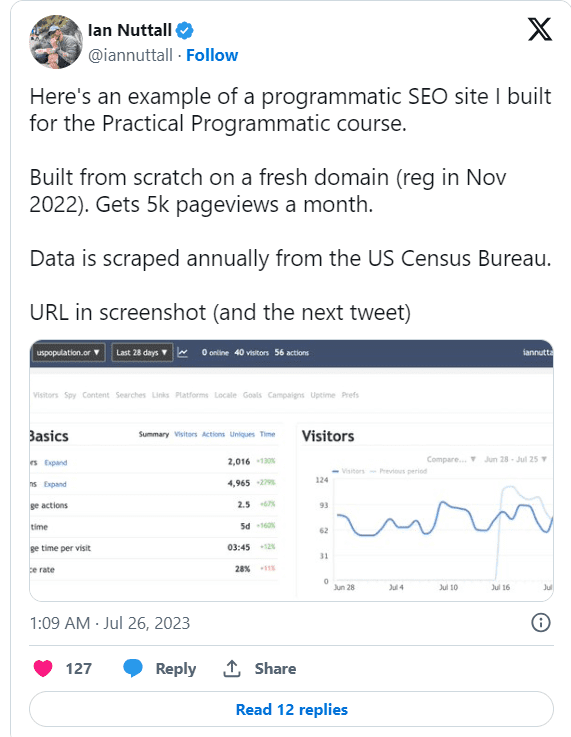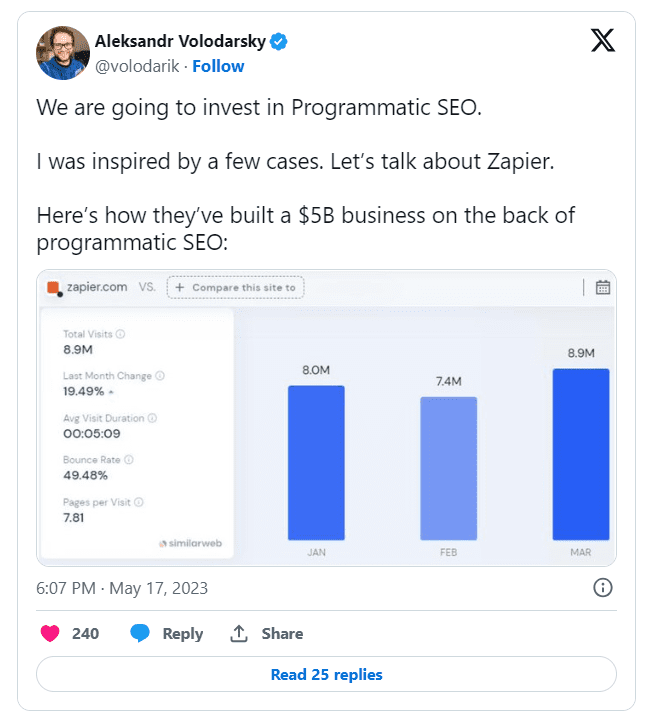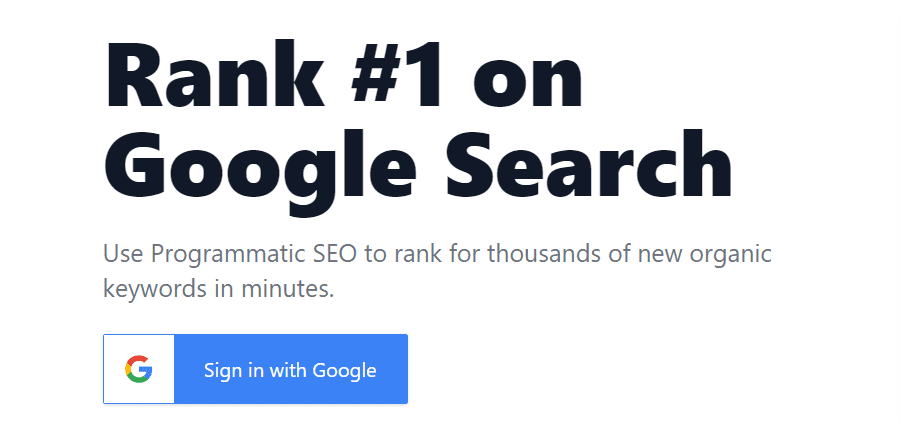Writing a great pillar article with the right keywords answering the top search queries, can help you make it to the top three results of Google.
However, writing thousands of such SEO-optimized articles or webpages at a moment’s notice can be difficult or unattainable. That’s where programmatic SEO can help.
You can publish thousands of web pages with programmatic SEO without any code or technical skills.
What’s Programmatic SEO?

Programmatic SEO can help you create SEO-optimized pages at scale. It uses datasets, pre-configured rules, and automation to instantly create pages. Unlike traditional SEO, it doesn’t rely on content that’s handwritten. Rather, it leverages the power of AI to create content that’s not plagiarized, accurate, and personalized.
Think Zapier, Glassdoor, TripAdvisor, and Canva – these are some of the websites that use programmatic SEO to create thousands of web-optimized pages that address specific search queries and search intent.
So, most websites take a template and create hundreds or thousands of variations of that. This works well for websites that need to have content for each location or each separate practice.
Programmatic SEO vs. SEO

Now, you might wonder what’s wrong with traditional SEO or why should you choose programmatic SEO over traditional SEO.
For starters, traditional SEO takes way more time and effort than programmatic SEO. It isn’t as fast as programmatic SEO, either. Moreover, producing great SEO efforts relies on a big content marketing team.
Programmatic SEO, on the other, is fast, cost-effective, and requires no developers or writers. You leverage the power of AI to run automation or write content that stands out.
Advantages & Disadvantages of Programmatic SEO

Well, there’s no getting around the fact that programmatic SEO can help you make the most of your marketing efforts at a more affordable spend. Here are the main advantages why you should take programmatic SEO for a spin:
- As paid marketing costs rise, programmatic SEO is a great way to keep costs down
- It doesn’t need a whole convoy of writers, editors, marketers, or engineers
- It can help you rank for in-depth content fast
While programmatic SEO has its advantages, it’s best to remember programmatic SEO isn’t for every business or every individual out there. There are certain difficulties that programmatic SEO can also bring, like:
- Indexing can be difficult with programmatic SEO
- There are limited data resources you could use to your advantage

If not used properly, it could hurt your site’s growth. Moreover, with the increasing number of pages, you’ll need to maintain and keep updating those pages. If you’re not ready to put in the effort regularly, it’s something that might not work for you.
How to Implement Programmatic SEO

#1. Find Your Head Terms
In programmatic SEO, you don’t target individual keywords. Instead, you target entire directories of keywords. You start off with what are head terms. A broad-level category your users might be searching for but getting very difficult results with each modified use case.
For example, if your head term is things-to-do-in, the results things-to-do-in-london will fetch you very different results from things-to-do-in-washington. Moreover, think in terms of an existing business: Canva.
Their head term will be the design template. Now, the modified use case can be a proposal design template, graphic design template, interior design template, or a thousand other things, depending on the specific search query. For Zapier, it’s integrations.
So, try and think of what purpose your business meets and what your users will be searching for.
#2. Identify Modifiers & Related Terms
Once you have locked in on the head term, you’ll be looking for related terms that work for your audience. For location-based things to do head terms, the different locations will serve as modifiers.
Moreover, if your head term is clothing, related terms that can work include clothing for men, clothing for women, clothing for kids, clothing for parties, etc. The modifiers can depend on occasions, gender, or any other differentiator that people tend to search for a lot.
#3. Check Analytics

Once you put together both head terms and related terms, you might want to run a quick Google Analytics on whether you’ll be generating enough unique keywords that people are searching for.
So, once you have a head term, try coming up with a few related terms and jot down a few potential keywords. Go to any keyword tool and see where these have any search volume to power your programmatic SEO process.
#4. Build Content Templates
The trick to creating thousands of SEO-optimized pages in programmatic SEO is through the creation of a template that works for all. This first template page will be the foundation of your campaign.
Designing it is tricky, but you can use the programmatic SEO we’ve mentioned below to help you with this part.
While designing your landing page, integrate these best practices:
- Meta title, meta description, H1, and H2s should have your head term
- Use breadcrumbs for efficient internal linking for search engines
- Have page hierarchies through XML sitemaps and heading hierarchies
- Use CTAs and rich snippets, optimize content for voice search, and integrate schema tags to support better crawling
- Use testimonials, reviews, and social-proof along with valuable content
#5. Connect to a Database
To yield the power of programmatic SEO, you need to connect it to a source of information. It can be a CSV file – a publicly available source of data or personalized data you’ve collected in your journey. Next, you’ll need to populate the data on your CMS. As the process can get complicated without the right tools, we recommend moving into the next section.
The process of populating multiple pages with programmatic SEO isn’t straightforward or achievable without the right tool. Which one should you choose? Take a look at the ones we’ve discussed below.
Which Programmatic SEO Tools to Consider?
#1. SEOBrrr
Increasing organic traffic to your site with programmatic SEO and no technical skills has been made easier by SEOBrrr. You can compete with the best players in the market by creating and managing programmatic SEO campaigns at scale.
In fact, this tool is really useful for nontechnical content marketers and SEO specialists. The editor is simple. All you need to do is add data and create a custom template by leveraging formatting options. If you want to use existing data, you can upload them in CSV format.
There’s no steep learning curve with SEOBrrr, and you can make changes to your templates and campaigns easily. Now, if you’re an agency and you’d like to manage multiple campaigns for multiple websites, you can do so as well.
There are 4 plans you can choose from: Starter, Plus, Professional, and Enterprise. They have a useful support team to help you through more queries.
#2. PageFactory
Get more traffic to your websites with less effort with PageFactory. It lets you automate the process of content creation by using programmatic SEO to your advantage. You know the real key to success lies not in high-volume keywords but in long-tail keywords suited to specific queries in your industry.
Hence, you can use them at scale by creating and managing campaigns. Moreover, you can add data in pre-made templates and publish your pages easily. If you want more traffic, all you have to do is add more data. That’ll make PageFactory create more content for you.
No longer do you need to hire or maintain a team of content writers? This programmatic SEO tool is faster than content writers and saves you the cost of hiring them, too! Neither do you need developers to create templates for your campaigns.
In fact, there’s no code required. You can publish to your existing websites using the website builders you’re already using. You can take a monthly or an annual plan after trying out their features for a 14-day free trial.
#3. Typemat

SERP SEO or ranking in the top three results of Google is achievable with Typemat‘s programmatic SEO. You’ll be ranking for organic keywords that are long-term, varied, and target a wider range of audiences.
Moreover, you can copy your data to Typemat and write a template. In fact, you can do this for unlimited sites. You can also directly connect to WordPress. There are other advantages built-in to Typemat that can come in really handy:
- Custom domains
- Easy setup in less than an hour
- East keyword addition to meta titles & description
#4. SEOmatic
With a 7-day free trial, SEOmatic automates content creation and improves SEO performance. It requires no coding skills and is easy and fast to set up. So, how does it work?
You can choose pre-made templates or use your website builder to create SEO-friendly pages. Next, you add datasets by using ready-to-use sets or uploading a CSV file for existing sets. Once that’s done, you can generate templates and target keywords in bulk. SEOmatic’s built-in AI will help you with the content.
Next, you can hit publish or host your pages via SEOmatic. There are numerous advantages to SEOmatic.
- A text editor like Notion that improves content creation
- An AI writer for plagiarism-free content that can make you rank high
- A Spintax generator to generate text variations to avoid duplicate content
- Datasets built-in for all niches
- Clusters for keyword modifiers for programmatic SEO
- Customizable page templates to kick off your programmatic SEO
What gives SEOmatic an edge is its drip publishing feature. It lets you generate content with a scheduling tool. You can also use the paraphrasing tool for efficient content creation. Moreover, SEOmatic supports the highest number of integrations, including WordPress, Shopify, Wix, and 125 other platforms.
#5. Alli AI
Alli AI makes automating, installing, deploying, and scaling your SEO efforts straightforward. You can use Alli AI to optimize multiple sites and deploy and test SEO changes immediately. In SEO, you know how crucial timing and doing-things-in-the-now is.
Alli AI can work with any CMS, requires no developers or coding, and has a 15-minute installation with a step-by-step guide. In fact, there’s also a customization automation option for every page. You can also monitor the changes you’re making to all pages with the highlight tool so that nothing escapes your attention.
Now, the best thing about Alli AI is its automation. However, its ability to change with your website seems to be better than that. When you make changes to your website, your customization automation options will still be updated regularly.
As SEO best practices evolve and algorithms change, Alli AI’s automation will keep adapting. Moreover, implementing effortless schema markup is also easy with this programmatic SEO tool.
Programmatic SEO can be the way forward.
If you have a deliverable or an offering that requires you to create hundreds of pages, programmatic SEO can be your savior. It’s important to use the right tool that’ll be able to whip up SEO-optimized pages without any help from your content guys or coding maestros.
In fact, remember crawling and indexing might take a while as you’re trying to rank for several pages.
Yes, it’s true that programmatic SEO helps you rank fast, but in certain cases, it can take a while if you’re not using tools that implement programmatic SEO strategically.
Keep refining your efforts and carry out several A/B tests of headlines, CTAs, descriptions, and their placements. Basically, see what improvements can be made.
You may also explore some best rank tracking and keyword manager SEO tools and programmatic advertising platforms.




